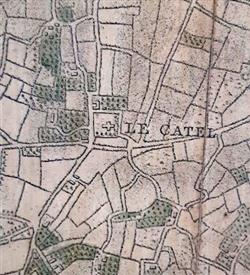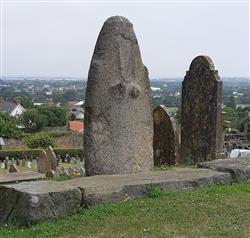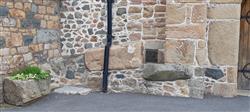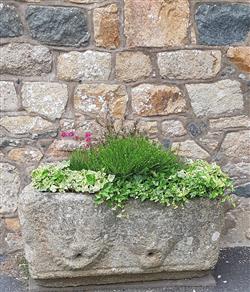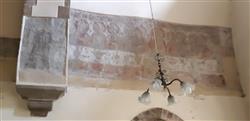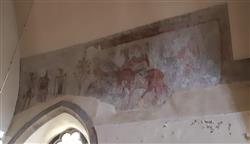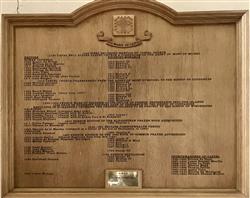The church at Castel, also known as Catel
Image from an old map showing fields and orchards around the church.
The church at Castel (or Le Catel to use Guernaise) stands on the highest point on the island. From there is a fine view of the surrounding countryside to the coast. There is evidence of a Neolithic settlement. A fine two metre high Neolithic Menhir in female form was found buried under the chancel step in 1878.
Huge stones are used in the foundations and walls of this church (some bearing crosses).
One giant stone - a possible menhir - makes the cover of a grave just in front of the church to the south.
Many centuries later on the Romans also used the site as a fortress.
Roman brick is to be found in the walls of the church and a Roman stone trough, now used for plants.
There are medieval wall paintings which were probably whitewashed out by the time of Jacques and Rachel.
Left - Woman carrying flagon and chalice with an axe across her neck.
Right - The Last Supper
The Dit des trois Morts et des trois Vifs
Three kings or wealthy young men, going hunting, encounter three skeletal beings in different states of decomposition by the tree of life. They have a brief exchange, but centered on the essential: “Tel que tu, tel je fus - et tu seras tel que je suis” (Such as you, such I was - and you will be such as I am.) This theme became popular around the 14th and 15th centuries.
The church has been much changed and enlarged over time, but one can make out the older architecture of the church that Jacques would have known.
Information from the List of Incumbents
ROMAN CATHOLIC
1048
The first recorded mention of Castel Church
1155
Papal Bull states Castel Church a possession of the Abbey of Mont St Michel
(there follows nine names of incumbents and dates)
1414
Castel Church transferred from the Abbey of Mont St Michel to the Bishop of Coutances)
(seven more names of incumbents and dates)
1562 - 1598
French wars of religion cause influx of French Protestants into the islands.
1568
Dean of Guernsey refuses Oath of Obedience to the Bishop of Coutances resulting in Elizabeth I ordering the Channel Islands to be subject to the Bishop of Winchester.
CALVINIST
1584
(five more names of incumbents and dates)
1616
French edition of the Elizabethan prayer book authorised.
(two more names of incumbents and dates)
1649 – 1660
English Commonwealth period
1655
Charles de la Marche (resigned as a result of the Act of Uniformity in 1662)
ANGLICAN
1662
Pierre Salamon
1667
French edition of the 1662 Book of Common Prayer Authorised (specifically for the Channel Islands and the Savoy area of London)
1674
Jacques Guille (church registers date from this time.)
1687
(Note that Jacques continues to use his French university title.)
1689
(There follows subsequent names of incumbents and dates)
